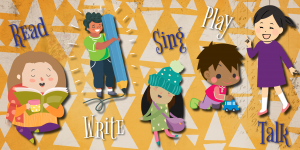
Creating art is a fantastic way for children to learn a variety of skills, from fine motor skills to the expression of feelings. But did you know that how you encourage your children to play with art impacts what skills they learn?
Educators sometimes discuss the difference between product-focused art and process-focused art. While there can be a time and place for product-focused art, process-focused art is invaluable in helping children learn about critical thinking, creativity, and problem-solving.
In product-focused art…
- The end product matters most.
- The grown up has an end result in mind they want the child to achieve.
- There is often a template or sample to show what it “should” look like.
- There is a wrong way to do the craft.
In process-focused art…
- The process of making the art is what matters.
- The child determines the end result, with the grown-up’s support.
- The art will be unique. There is no set way it “should” look.
- There are no “wrong” or “right” ways to do the craft.
Allowing your children the freedom to create, rather than follow a rigid plan, helps them determine the outcome and find ways to reach the goals they have set. Just as with other types of play, grown-ups can still support children in their art by suggesting new ideas or asking questions about why children are making the decisions they are.
Need ideas about things you can create?
A barrier to children (and often adults!) can be feeling that one’s work isn’t “good enough.” Be sure to encourage them that making mistakes is OK, and can even lead to something amazing!
-Kelly, Children's Librarian, Joel D. Valdez Main Library
Source
Characteristics of process-focused art experiences
 Read, Write, Talk, Sing, Play!
Read, Write, Talk, Sing, Play!
Play comes so naturally to children and is an essential element to lifelong success. When children play, they are practicing and perfecting early literacy and life skills!
Read more about early literacy and how you can make a difference in your child's life.

